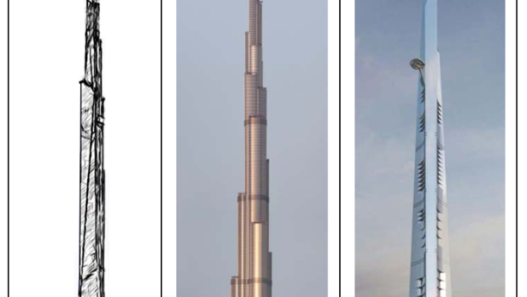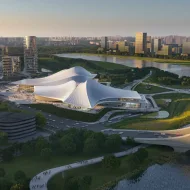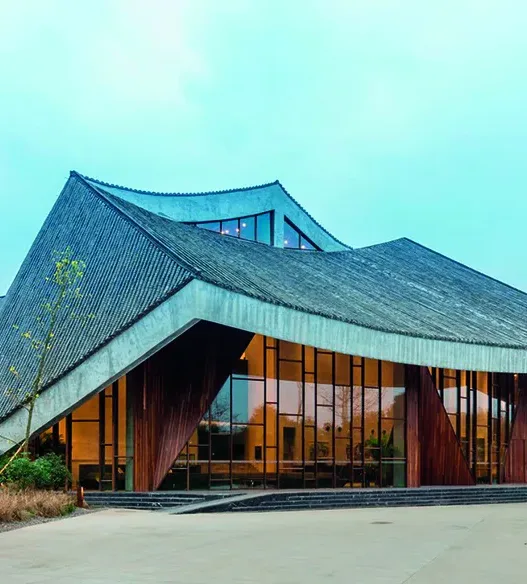The University of Michigan Taubman College of Architecture and Urban Planning is at the forefront of innovation and sustainability in architectural education. Founded with a vision to push the boundaries of design, the school has become a hub for aspiring architects and urban planners. Emphasizing the interconnectedness of design and the environment, the college encourages a holistic understanding of how architecture can impact society and vice versa. With a commitment to sustainability, Taubman College not only prepares students for the challenges of contemporary design, but also instills a sense of responsibility toward the planet.

Historical Context
Taubman College's roots date back to the early 20th century, when architecture began to emerge as a distinct field of study within universities. The college has evolved over the decades to adapt to the changing landscape of architecture and urban planning. The college's establishment was a response to the increasing need for architects who could address complex urban problems, especially during times of social and economic upheaval. This historical context is important because it highlights the role of the university in shaping not only individual careers but also the broader field of architectural education.
Architectural Vision
At the heart of Taubman College’s mission is a visionary approach that combines aesthetic sensitivity with practical functionality. The college encourages students to rethink traditional concepts of architecture by integrating sustainable practices into their designs. This vision goes beyond mere construction to include the creation of spaces that foster community, support environmental stewardship, and enhance the quality of life. By emphasizing design thinking, the college prepares students to tackle real-world challenges and encourages them to envision the future of urban environments in a sustainable way.
Importance in Education
Taubman College plays a key role in architectural education by providing a curriculum that is both rigorous and innovative. The college not only teaches technical skills, but also fosters critical thinking and creativity. Students are encouraged to engage with their environment, understand the socio-economic context of their designs, and experiment with new materials and technologies. This educational philosophy is especially important in today’s world, where architects must be equipped to address issues such as climate change and urbanization. The college fosters a collaborative environment where students learn from each other and from experienced faculty, preparing them to become leaders in the field.
Key Architects Participating
Taubman College’s legacy is enriched by the contributions of prominent architects and educators who have been integral to its development. These prominent figures have helped shape the curriculum and the college’s architectural identity. Their diverse backgrounds and perspectives provide students with a wealth of knowledge and insight into a variety of architectural styles and philosophies. The involvement of leading architects not only enhances the college’s reputation, but also serves as a source of inspiration for students and encourages them to explore their own unique design voices.
Design Process Overview
The design process at Taubman College is a dynamic, iterative journey that emphasizes experimentation and reflection. Students are guided through various stages from conceptualization to implementation, allowing them to engage deeply with their projects. This process often involves collaboration with local communities and stakeholders, ensuring that designs are not only innovative but also relevant and beneficial to society. With a focus on sustainability, the college encourages students to consider the environmental impact of their designs, and advocates for solutions that balance aesthetics with ecological responsibility. Through this comprehensive approach, Taubman College is preparing a new generation of architects who are equipped to face the complexities of modern urban living.
# Taubman College At The University Of Michigan: Combining Sustainability With Design
Architectural Features
The University of Michigan Taubman School of Architecture and Urban Planning stands out as a beacon of innovative design and sustainability. Its architectural features not only showcase aesthetic appeal, they also embody principles that address environmental concerns and promote well-being. These elements work together to create a vibrant educational environment that inspires both students and faculty.
Innovative Material Use
Central to Taubman College’s architectural design is a commitment to using both sustainable and innovative materials. The building utilizes a variety of eco-friendly materials that enhance the aesthetic quality of the space while reducing environmental impact. For example, the use of reclaimed wood not only adds warmth to the interior spaces, but also minimizes waste by reusing materials from previous structures. Additionally, the use of high-performance glass allows for abundant natural light, reducing the need for artificial lighting during the day. This thoughtful approach to material selection demonstrates how architecture can harmonize with nature and promote sustainability without sacrificing beauty.
Spatial Organization
The spatial organization within Taubman College is meticulously crafted to encourage collaboration and creativity among students. The layout encourages interaction with open spaces that invite spontaneous discussions and brainstorming sessions. Classrooms and studios are designed to be flexible to allow for a variety of teaching styles and methods. By moving away from traditional, compartmentalized designs, the college fosters the sense of community and collaboration necessary for developing the next generation of architects and urban planners. This fluidity not only enhances the educational experience, but also reflects the dynamic nature of the disciplines taught within Taubman College’s walls.
Unique Facade Design
One of the most striking features of Taubman College is its unique façade design, which serves both functional and aesthetic purposes. The exterior is characterized by a blend of geometric shapes and textures that create visual interest while allowing for efficient energy use. The exterior features shading devices that respond to the sun’s movement, reducing heat gain and glare inside the building. This innovative design element not only contributes to the overall sustainability of the building, but also exemplifies the university’s mission to integrate design with environmental responsibility. The façade becomes a canvas that expresses the university’s commitment to forward-thinking architectural practices.
Interior Design Elements
Taubman College’s interior design reflects a commitment to creating spaces that are not only functional but also inspiring. The use of color, texture, and light play a key role in enhancing the learning environment. Common areas are furnished with comfortable seating and collaborative workspaces that encourage students to interact and share ideas. The interiors are adorned with artwork and installations that celebrate creativity and innovation, further enhancing the atmosphere. Additionally, biophilic design principles are evident as natural elements are integrated throughout the space, encouraging well-being and a connection to the outdoors.
Integration with the Environment
Taubman College’s design seeks to extend beyond its walls and establish a harmonious relationship with its surroundings. The building is strategically positioned to complement the natural landscape and existing architecture on campus. Thoughtful landscaping features native plants that increase biodiversity while reducing irrigation requirements. Pathways and open spaces blur the lines between indoor and outdoor environments, encouraging movement and interaction among students. This integration fosters a sense of place and belonging, making Taubman College not just a building but a vital part of the campus community.
As a result, the architectural features of Taubman College at the University of Michigan exemplify the harmonious blending of sustainability and design. Through innovative materials, careful spatial organization, unique facades, inspiring interiors, and seamless integration with the surroundings, the college stands as a testament to what modern architecture can achieve. It serves not only as a learning space, but also as a model for future architectural efforts that prioritize environmental responsibility and community engagement.
# Taubman College At The University Of Michigan: Combining Sustainability With Design
Sustainability Initiatives
At Taubman College, a commitment to sustainability is evident in every aspect of architectural and educational practice. The college not only educates future architects, but also emphasizes the importance of sustainable design in addressing global challenges. Taubman College aims to create a harmonious balance between ecological responsibility and aesthetic design through innovative sustainability initiatives.
Energy Efficiency Strategies
Energy efficiency is a cornerstone of sustainable architecture, and Taubman College implements several strategies to reduce energy consumption. The design of the buildings incorporates advanced insulation techniques, energy-efficient windows, and smart lighting systems that adjust to natural light availability. The college significantly reduces its carbon footprint by using renewable energy sources such as solar panels.
For example, the integration of passive solar design principles allows buildings to harness sunlight for natural heating and lighting, reducing reliance on artificial sources. This not only minimizes energy costs, but also creates healthier indoor environments. Students at Taubman are encouraged to explore these strategies in their projects, helping them understand the important role energy efficiency plays in modern architecture.
Water Saving Measures
Water conservation is another vital aspect of sustainability that Taubman College prioritizes. Recognizing the importance of conserving this valuable resource, the College takes several measures to effectively manage water use. Rainwater harvesting systems are implemented to collect and reuse rainwater for irrigation and non-potable uses, greatly reducing the demand on municipal water supplies.
Additionally, low-flow fixtures and smart irrigation systems are standard throughout the university’s buildings and landscapes. These technologies not only save water, they also educate students about the importance of responsible water management in architectural design. By emphasizing these practices, Taubman College fosters a culture of sustainability that students will carry into their future careers.
Sustainable Material Selection
Choosing sustainable materials is crucial to reducing the environmental impact of construction. At Taubman College, students are taught to consider the origins and life cycles of materials, opting for renewable, recycled or locally sourced ones. This approach not only minimizes the carbon footprint of transportation, but also supports local economies.
For example, the use of reclaimed wood and recycled metal in construction projects demonstrates how sustainable materials can enhance aesthetic appeal while promoting environmental responsibility. By exploring innovative materials, students learn how thoughtful selection can lead to more sustainable building practices and ultimately impact the broader architectural landscape.
Green Roof and Landscape
Green roofs and sustainable landscaping practices are an integral part of Taubman College’s commitment to sustainability. Green roofs not only provide insulation and reduce the urban heat island effect, they also promote biodiversity by creating habitats for a variety of species. These living roofs can absorb rainwater, reduce stormwater runoff, and improve air quality.
The landscape surrounding the college is designed to be both beautiful and functional, with native plants that require less water and maintenance. This approach reflects a deep understanding of the local ecosystem and allows students to appreciate the synergy between architecture and nature. By incorporating these elements into their designs, students learn how landscapes can be designed to support sustainability and enhance the overall environment.
LEED Certification Goals
LEED (Leadership in Energy and Environmental Design) certification is a globally recognized symbol of sustainability achievement. Taubman College aims for its buildings to achieve high LEED ratings, which require buildings to meet rigorous standards for energy efficiency, water conservation, and sustainable materials. This commitment not only demonstrates the college's commitment to sustainable practices, but also serves as a teaching tool for students.
By engaging in the LEED certification process through coursework and real-world projects, students gain valuable insight into what it takes to create a building that meets these stringent criteria. They learn the importance of integrating sustainability into every phase of design and construction, preparing them for careers in an industry that increasingly values environmental stewardship.
As a result, the University of Michigan’s Taubman College is at the forefront of integrating sustainable practices into architectural education. Focusing on energy efficiency, water conservation, sustainable materials, green landscaping, and LEED certification, the college is educating a generation of architects who are not only talented in design but also deeply committed to creating a sustainable future.
# Taubman College At The University Of Michigan: Combining Sustainability With Design
Impact on the University Community
The University of Michigan Taubman College of Architecture and Urban Planning stands out as a beacon of innovative design and sustainability. Its impact extends far beyond the boundaries of its buildings and permeates the university community in a variety of meaningful ways. This section examines how Taubman College enhances student learning, encourages community engagement, hosts events, collaborates with other departments, and thrives through alumni contributions.
Improving Student Learning
The learning environment at Taubman College is deeply embedded with the principles of sustainable design. Students are not simply recipients of information but active participants in a hands-on educational experience. The curriculum emphasizes real-world applications and encourages students to engage with sustainable practices through projects that address pressing societal challenges. For example, students may work on urban renewal projects that include green space or develop designs for energy-efficient buildings. This experiential learning approach not only enriches their education, it also instills a sense of responsibility to the environment and the communities they serve.
Community Engagement Programs
Community engagement is a cornerstone of Taubman College’s mission. The college actively seeks to connect with local neighborhoods and foster partnerships that benefit both students and residents. Programs often include collaborative design workshops, where students work with community members to identify problems and brainstorm solutions. This symbiotic relationship allows students to apply their skills in real-life contexts while also voicing the needs of community stakeholders. Such initiatives not only enhance the educational experience, they also foster a sense of belonging and mutual respect between the university and the surrounding community.
Hosting Events and Workshops
Taubman College is a hub of events and workshops that bring together students, faculty, and industry professionals. These gatherings often focus on sustainability and innovative design practices, providing a platform for dialogue and collaboration. Guest speakers from diverse backgrounds share their insights, inspiring students and encouraging them to think critically about their designs. Workshops provide hands-on learning where participants can try out new technologies or methodologies in a supportive environment. Through these events, Taubman fosters a vibrant community of students passionate about making a difference.
Collaborations with Other Departments
Taubman College’s multidisciplinary approach sets it apart. Collaborations with other departments within the university enrich the educational experience and broaden the scope of projects. For example, partnerships with engineering or environmental science departments allow students to tackle complex design challenges from different perspectives. This integrative approach not only improves the quality of projects, it also prepares students for the collaborative nature of the professional world. By working with peers from different disciplines, students gain valuable insights that shape their understanding of architecture and urban planning.
Contributions and Feedback from Alumni
Taubman College’s influence extends into the professional arena, in large part through its engaged alumni network. Alumni often return to contribute their expertise and provide feedback on current programs and initiatives. This connection between past and present students creates a supportive ecosystem that fosters mentorship and collaboration. Alumni frequently share their experiences and lessons learned in the field, providing current students with invaluable perspectives as they prepare to enter the workforce. Ongoing engagement with alumni not only strengthens the college community, but also ensures that educational offerings remain relevant and impactful.
In sum, Taubman College’s impact on the University of Michigan community is profound and multifaceted. Through innovative educational practices, community engagement, collaborative efforts and a strong alumni network, Taubman College not only shapes the future of its students, but also makes significant contributions to the sustainability and resilience of the communities it serves.
# Taubman College At The University Of Michigan: Combining Sustainability With Design
5. Recognition and Awards
Architectural Awards Won
Taubman College of the University of Michigan has been widely recognized for its innovative approach to architecture and urban planning. The college’s commitment to sustainability and design excellence has earned it numerous architectural awards. These awards not only celebrate the college’s achievements, but also highlight its role in shaping the future of environmentally responsible architecture. Notable awards include honors from the American Institute of Architects (AIA), which recognize outstanding architectural projects that make positive contributions to communities and the environment. Each award sets a benchmark for architectural education by demonstrating the college’s ability to combine aesthetic appeal with sustainable practices.
Highlights in Media Coverage
The media has focused extensively on Taubman College, frequently highlighting its pioneering programs and initiatives. Feature stories in leading architecture journals and mainstream publications have showcased the college’s sustainable designs and innovative teaching methods. Articles frequently highlight specific projects that exemplify the integration of green technologies and design creativity. This media presence not only enhances the university’s reputation, but also inspires other institutions to prioritize sustainability in their curricula and practices. The stories shared across multiple platforms underscore Taubman’s impact and solidify its position as a leader in architectural education.
Impact on Future Designs
Taubman College’s innovative projects are a springboard for future architectural design. The college’s commitment to sustainability and forward-thinking approach inspires students and professionals alike to rethink traditional design paradigms. By incorporating renewable materials, energy-efficient systems, and community-focused planning, Taubman is shaping a new generation of architects who are prepared to address pressing environmental challenges. This impact extends beyond the campus, affecting local communities and even global architectural trends. As the college continues to push boundaries, it contributes to a growing movement that prioritizes sustainable design as a fundamental aspect of architectural practice.
Reviews from Critics
Critics and industry experts frequently express admiration for the work produced by Taubman College students and faculty. These testimonials emphasize the college’s unique ability to foster creativity while instilling a strong sense of social responsibility. Many have noted how the college’s projects resonate not only with their design but also with their societal impact. Critics frequently praise the integration of academic rigor with real-world practice and emphasize that Taubman graduates emerge as thoughtful and innovative professionals prepared to tackle contemporary issues in architecture. Such recognitions reflect the college’s commitment to excellence and its role in advancing architectural education.
The Role of Academic Rankings
Taubman College’s sustainability and design achievements have significantly impacted its position in academic rankings. The college consistently ranks among the nation’s top architecture schools, a testament to its rigorous academic programs and research initiatives. Contributing factors to these rankings include faculty expertise, research output, and the successful placement of graduates in leading architecture firms. As sustainability becomes an increasingly important criterion in architectural education, Taubman’s focus on this area enhances its reputation and attracts top talent. The college’s role in shaping the architects of the future is clear as it prepares them to lead the charge in creating a more sustainable built environment.
# Taubman College At The University Of Michigan: Combining Sustainability With Design
6. Conclusion and Future Prospects
In the ever-evolving world of architecture and design, the University of Michigan’s Taubman College stands out as a beacon of innovation and sustainability. As we look toward the future, it becomes clear that the college is not just a place of learning, but also a dynamic center for research, collaboration, and architectural evolution. Its ongoing commitment to combining sustainability with cutting-edge design principles is paving the way for a new era in architectural education.
Ongoing Research Initiatives
Research initiatives at Taubman College are vibrant and diverse, reflecting the university’s commitment to addressing contemporary challenges in architecture and urban planning. Faculty and students are involved in projects investigating sustainable building materials, energy-efficient designs, and urban resilience. For example, recent studies have focused on the impacts of climate change on urban environments and are seeking innovative solutions that promote ecological balance. Collaborative efforts with local communities and industries further enrich these initiatives, ensuring that research is not only theoretical but also applicable and impactful in the real world.
Future Expansion Plans
Looking ahead, Taubman College is poised for significant growth. Future expansion plans include the development of new facilities that will enhance the learning environment and accommodate a growing student body. These facilities will integrate advanced technologies and sustainable practices, such as green roofs and renewable energy sources. The vision is to create spaces that foster creativity and collaboration, and to allow students to engage in hands-on projects that address pressing architectural challenges. This expansion not only enhances educational opportunities, but also solidifies the university’s position as a leader in sustainable design.
Continued Commitment to Sustainability
Sustainability is not just a fad at Taubman College; it is an integral part of the institution’s philosophy. The college is committed to cultivating an environment where sustainable practices are incorporated into every aspect of education and research. This commitment is reflected in the curriculum, which emphasizes the importance of environmentally friendly design and materials. Students are encouraged to think critically about the environmental impacts of their designs and to prioritize sustainability throughout their projects. By fostering a culture of sustainability, Taubman College prepares graduates to be responsible architects and planners who can lead the industry toward a more sustainable future.
Emerging Architectural Trends
The field of architecture is constantly evolving, influenced by cultural shifts, technological advances, and environmental concerns. Taubman College is at the forefront of these trends, adapting its programs to prepare students for the challenges ahead. New trends such as biophilic design, which emphasizes the connection between nature and the built environment, are increasingly being incorporated into the curriculum. Additionally, the rise of smart building technologies is reshaping how architects approach design, emphasizing efficiency and the user experience. By adapting to these evolving trends, Taubman College ensures that its graduates are well-equipped to innovate and lead in a rapidly changing industry.
Final Thoughts on Taubman College
As a result, Taubman College at the University of Michigan represents a forward-thinking approach to architectural education. With its steadfast commitment to sustainability, its commitment to research, and its keen awareness of evolving trends, the college is meaningfully shaping the future of architecture. By continuing to expand and innovate, Taubman College not only prepares its students for successful careers, but also contributes to a more sustainable and caring built environment. The future of architecture is bright at Taubman College, where design meets responsibility and students are empowered to make a positive impact on the world.





















